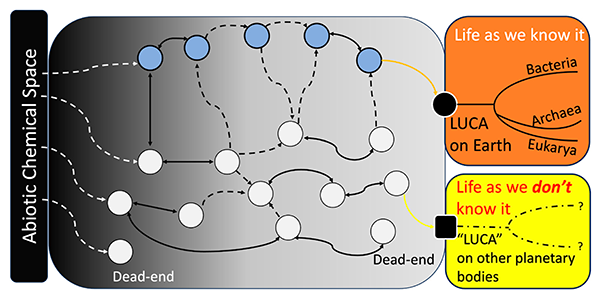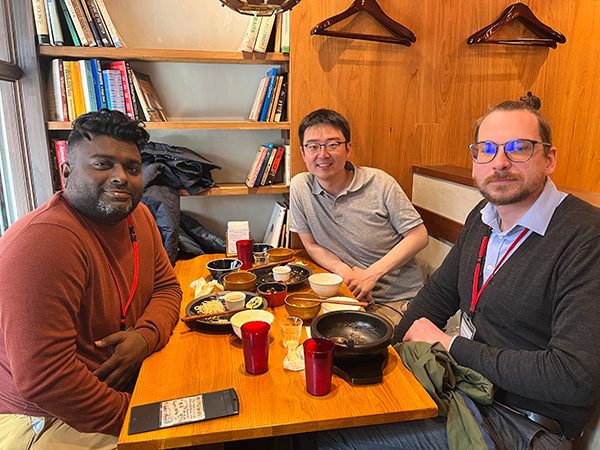
Modern life is composed of biological molecules such as lipids, nucleic acids, and proteins, and it results from billions of years of evolution on Earth. Understanding the origin of life on Earth is thus a tall order, as it requires understanding a litany of processes that one observes in modern biology/on modern Earth, as well as those which are predicted to have occurred in the past on ancient Earth. To that end, a number of studies on the origins of life on Earth have focused on the origin and evolution of biomolecules, which has resulted in a number of theories that the origins of life field has continued to be investigated to this day; some theories suggest that evolution “converged” onto the current form of Terrestrial life. For example, there are certain molecules or processes that appear to “define” life, and searches for life off of Earth seek similar molecules or processes in an attempt to discover extraterrestrial life. However, life on Earth as we know it is exactly that—it is literally the only life that is known. While it is possible that life off of Earth could take the same or similar form, there is also the possibility that life off of Earth takes a completely different form, and there may be no way to know exactly what form extraterrestrial life takes. Perhaps extraterrestrial life uses different chemicals in their biology, or different chemical reactions are the key to sustaining extraterrestrial life. The fact that extraterrestrial life could take a different from than what is known could be due to a variety of reasons, such as environmental conditions, but also due to random events, i.e., contingencies. In the “deterministic” viewpoint, regardless of such contingencies, the final end result, i.e., life, will be somewhat similar (to what is observed on Earth). However, it is very plausible that such contingencies could push life off of Earth into a completely different pathway, and extant terrestrial life could even be the result of contingencies!
Thus, the authors propose a model accounting for contingency in the origins of life. Specifically, they suggest that before LUCA (the last universal common ancestor, an organism that generally is believed to signify “life”), a number of different chemical states, i.e., groups of chemicals that existed as mixtures on early Earth, would have been present on Earth. These chemical states would have changed according to the environmental conditions at the time, any reactions that members could participate in, as well as contingencies. Over time, life/LUCA would have emerged following a long period of chemical evolution, allowing progression of chemical states from less life-like to more life-like forms. However, there are also cases where chemical states could undergo evolution and the end result does not result in life (i.e., a dead end). Similarly, if we don’t strictly define “life” as identical to that which is observed on Earth, then it is plausible that evolution of some chemical states could lead to life as we “don’t” know it. It is precisely this life as we “don’t” know it which provides an interesting viewpoint for the search for extraterrestrial life, as if one continues to only search for life as we know it, then perhaps one may be blind to the fact that it is plausible that life has already been found off of Earth!
However, what should one look for if one wants to search for life as we “don’t” know it? This is a very difficult question and requires much deeper exploration, as well as collaborative efforts from a wide range of researchers across a number of disciplines. Nevertheless, as a starting point, the authors note that perhaps researchers can consider the possibility that so-called non-biomolecules, those that either aren’t found in biology or serve roles different to their biochemical functions, could be the key.
“Non-biomolecules, while perhaps not leading directly to the origin of modern biomolecules, could have played auxiliary roles during the origins of life,” says co-author Kuhan Chandru of National University of Malaysia. “Perhaps non-biomolecules could have formed structures or participated in chemical reactions that produced products that scaffolded or supported some other process that directly led to life, suggesting their indirect participation in the origins of life; we should continue to pursue further understanding of the role of non-biomolecules in the initial emergence of life on and off Earth!”

| Journal | Life |
| Title of the paper | Alternative Pathways in Astrobiology: Reviewing and Synthesizing Contingency and Non-Biomolecular Origins of Terrestrial and Extraterrestrial Life |
| Affiliations | Kuhan Chandru1,2,3,*, Christian Potiszil4; and Tony Z. Jia5,6,* |
| Affiliations | 1. Space Science Center (ANGKASA), Institute of Climate Change, National University of Malaysia, Selangor 43600, Malaysia 2. Polymer Research Center (PORCE), Faculty of Science and Technology, National University of Malaysia, Selangor 43600, Malaysia 3. Institute of Physical Chemistry, CENIDE, University of Duisburg-Essen, 45141 Essen, Germany 4. The Pheasant Memorial Laboratory for Geochemistry and Cosmochemistry, Institute for Planetary Materials, Okayama University, Misasa 682-0193, Tottori, Japan 5. Blue Marble Space Institute of Science, Seattle, WA 98104, USA 6. Earth-Life Science Institute, Tokyo Institute of Technology, Meguro-ku 152-8550, Tokyo, Japan |
| DOI | 10.3390/life14091069 |
| Online published date | 27 August 2024 |
